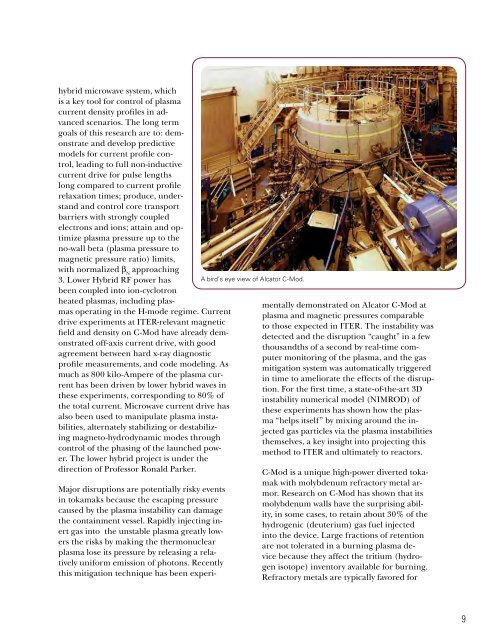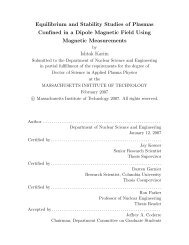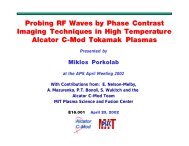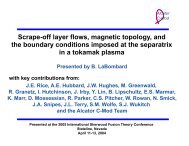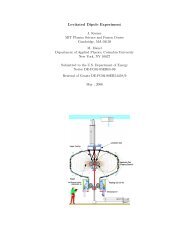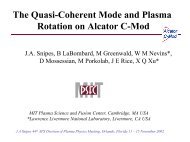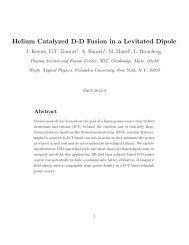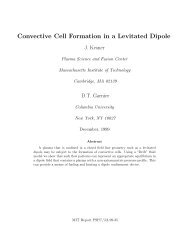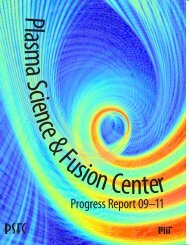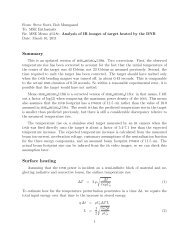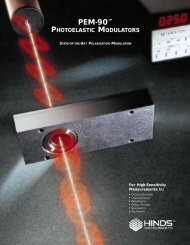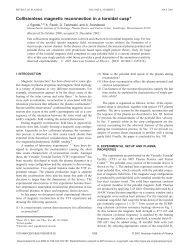From the Director - Plasma Science and Fusion Center - MIT
From the Director - Plasma Science and Fusion Center - MIT
From the Director - Plasma Science and Fusion Center - MIT
You also want an ePaper? Increase the reach of your titles
YUMPU automatically turns print PDFs into web optimized ePapers that Google loves.
hybrid microwave system, which<br />
is a key tool for control of plasma<br />
current density profiles in advanced<br />
scenarios. The long term<br />
goals of this research are to: demonstrate<br />
<strong>and</strong> develop predictive<br />
models for current profile control,<br />
leading to full non-inductive<br />
current drive for pulse lengths<br />
long compared to current profile<br />
relaxation times; produce, underst<strong>and</strong><br />
<strong>and</strong> control core transport<br />
barriers with strongly coupled<br />
electrons <strong>and</strong> ions; attain <strong>and</strong> optimize<br />
plasma pressure up to <strong>the</strong><br />
no-wall beta (plasma pressure to<br />
magnetic pressure ratio) limits,<br />
with normalized b N<br />
approaching<br />
3. Lower Hybrid RF power has<br />
been coupled into ion-cyclotron<br />
heated plasmas, including plasmas<br />
operating in <strong>the</strong> H-mode regime. Current<br />
drive experiments at ITER-relevant magnetic<br />
field <strong>and</strong> density on C-Mod have already demonstrated<br />
off-axis current drive, with good<br />
agreement between hard x-ray diagnostic<br />
profile measurements, <strong>and</strong> code modeling. As<br />
much as 800 kilo-Ampere of <strong>the</strong> plasma current<br />
has been driven by lower hybrid waves in<br />
<strong>the</strong>se experiments, corresponding to 80% of<br />
<strong>the</strong> total current. Microwave current drive has<br />
also been used to manipulate plasma instabilities,<br />
alternately stabilizing or destabilizing<br />
magneto-hydrodynamic modes through<br />
control of <strong>the</strong> phasing of <strong>the</strong> launched power.<br />
The lower hybrid project is under <strong>the</strong><br />
direction of Professor Ronald Parker.<br />
A bird’s eye view of Alcator C-Mod.<br />
Major disruptions are potentially risky events<br />
in tokamaks because <strong>the</strong> escaping pressure<br />
caused by <strong>the</strong> plasma instability can damage<br />
<strong>the</strong> containment vessel. Rapidly injecting inert<br />
gas into <strong>the</strong> unstable plasma greatly lowers<br />
<strong>the</strong> risks by making <strong>the</strong> <strong>the</strong>rmonuclear<br />
plasma lose its pressure by releasing a relatively<br />
uniform emission of photons. Recently<br />
this mitigation technique has been experimentally<br />
demonstrated on Alcator C-Mod at<br />
plasma <strong>and</strong> magnetic pressures comparable<br />
to those expected in ITER. The instability was<br />
detected <strong>and</strong> <strong>the</strong> disruption “caught” in a few<br />
thous<strong>and</strong>ths of a second by real-time computer<br />
monitoring of <strong>the</strong> plasma, <strong>and</strong> <strong>the</strong> gas<br />
mitigation system was automatically triggered<br />
in time to ameliorate <strong>the</strong> effects of <strong>the</strong> disruption.<br />
For <strong>the</strong> first time, a state-of-<strong>the</strong>-art 3D<br />
instability numerical model (NIMROD) of<br />
<strong>the</strong>se experiments has shown how <strong>the</strong> plasma<br />
“helps itself” by mixing around <strong>the</strong> injected<br />
gas particles via <strong>the</strong> plasma instabilities<br />
<strong>the</strong>mselves, a key insight into projecting this<br />
method to ITER <strong>and</strong> ultimately to reactors.<br />
C-Mod is a unique high-power diverted tokamak<br />
with molybdenum refractory metal armor.<br />
Research on C-Mod has shown that its<br />
molybdenum walls have <strong>the</strong> surprising ability,<br />
in some cases, to retain about 30% of <strong>the</strong><br />
hydrogenic (deuterium) gas fuel injected<br />
into <strong>the</strong> device. Large fractions of retention<br />
are not tolerated in a burning plasma device<br />
because <strong>the</strong>y affect <strong>the</strong> tritium (hydrogen<br />
isotope) inventory available for burning.<br />
Refractory metals are typically favored for<br />
9


